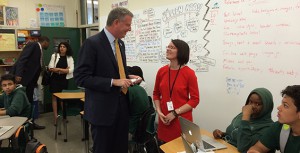In spring 2014, seniors at Hudson High School for Learning Technologies in NYC worked on a semester-long independent study project that required interaction with experts in a professional field
By Joy Nolan, Instructional Designer/Curriculum Specialist for Digital Ready
In summer 2013, Digital Ready, a program from New York City Department of Education’s Office of Postsecondary Readiness, began work with 10 high schools to promote research-based student-centered innovations, largely based on ideas and papers (such as Motivation, Engagement, and Student Voice) from Students at the Center, an initiative funded by Nellie Mae Education Foundation and The Hewlett Foundation and managed by Jobs for the Future.
As schools forged goals and designed innovations, our team created and shared 7 program benchmarks to articulate our best thinking about how to create meaningful, effective, and durable student-centered shifts in schools. It was an action-packed year for our team and our 10 schools, and we were pleased to see student surveys indicate that this work made a genuine difference. I’d like to share my two biggest takeaways from Digital Ready’s first year, and examples from our schools:
Takeaway 1: Student ownership of learning holds immense power as an educational tactic.
Of course student ownership is one of Digital Ready’s program benchmarks, but our first year convinced me anew of its incredible force and potential. When students in a rigorous academic setting are empowered to choose topics, partners, and means of demonstrating their learning, they bloom. They master new content and skills, discover new interests and capabilities, become more curious about the world at large, and engage with each other and their content more deeply.
For a strong example of student ownership of learning, check out The Big Idea Project. Last spring, students at Hudson High School of Learning Technologies in the Chelsea neighborhood of New York City spent 17 weeks on the project, whose tagline is “Own your own education.” Hudson seniors designed their own spring semesters. Each teen chose a study topic, found experts in their chosen field, engaged in real-world work with a social-action dimension, and documented and presented their learning. “They kept talking to us about passion, passion, passion. I was one of these kids who wanted very structured learning. I struggled in the beginning,” says Raul, a senior at Hudson. “I have come to the realization that this . . . is what kids need. Something that will get them engaged to do something they want to do. It was a great experience and now I’m getting ready to publish an article in the Huffington Post. This project has touched me.”
“It’s been exciting, scary, and awesome, honestly. This whole experience has made me more confident,” says Mayar, another Hudson senior. “It made me feel like I can actually change something in this world.” Mayar’s comment leads nicely to…
Takeaway 2: Follow the delight.
The strongest examples of student ownership of learning seem to be accompanied by a sense of delighted discovery, both for students and for teachers.
The presence of delight can serve as a strong indicator of effective transfer of learning. It happens when students are accomplishing rigorous academic feats they (and their teachers) maybe didn’t know they could master. Witnessing this shared delight in classrooms around the city brought the most rewarding moments of this first year, for me. I’ve come to believe that delight can basically serve as a Geiger counter for good practice around student ownership of learning.
At Bronx Academy for Software Engineering (BASE), freshman students were proud to discover that they could use Google Drive to design and run a successful Socratic Seminar across four different sections of a Global Studies class. “Digital Ready has helped students to become the leaders in the class, especially with this debate. As the teacher, I had never actually done a debate before,” said Stephina Fisher, BASE social studies teacher. “So, my first instinct was to turn to the experts: my students.” They were more than happy to oblige. Everyone at BASE was excited about what these 9th grade students were able to achieve with technology, a willing teacher, and their own impetus.
New York City Mayor Bill de Blasio visits the classroom of global teacher Stephina Fisher at Bronx Academy for Software Engineering, spring 2014 (Photo courtesy of BASE)
“What’s so exciting for us,” says Scott Massey, assistant principal at BASE, “is that Stephina’s classroom is not only student centered, but it’s really about bringing students in as collaborators in every aspect of the learning, designing, learning activities, designing curricula, designing assessments. [She is] sitting with students to create the learning experiences with them as partners.”
These examples involve students from around New York City, but they share the delighted sense of discovery, autonomy and capability, and the energy—and they both begin to illustrate the power of unleashing content and giving students a sense of genuine, meaningful ownership of their own learning. When implementing student-centered innovations, the presence of energetic delight in students and teachers can be a good indicator that rich, multidimensional learning is happening.
Further reading on student-centered approaches and student ownership of learning:
- Students at the Center, an initiative of Jobs for the Future with support from the Nellie Mae Education Foundation
- Putting Students in Charge of Their Learning by Nancy Hoffman, Rebecca E. Wolfe, and Adria Steinberg
- Anytime, Anywhere: Student-Centered Learning for Schools and Teachers, edited by Rebecca E. Wolfe, Adria Steinberg, and Nancy Hoffman
Digital Ready is managed by the NYC Department of Education’s Office of Postsecondary Readiness, with generous support from the NYC Mayor’s Office of Media and Entertainment.
